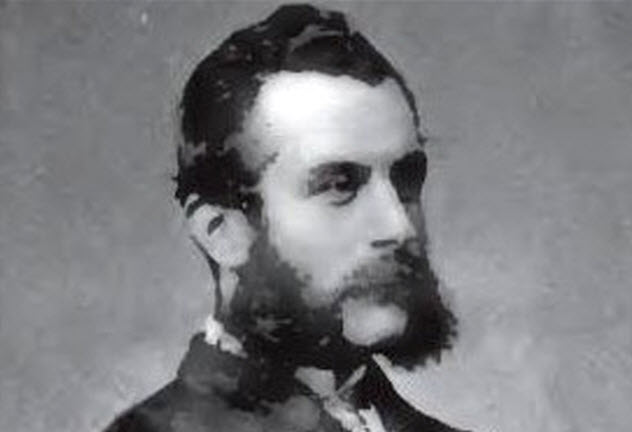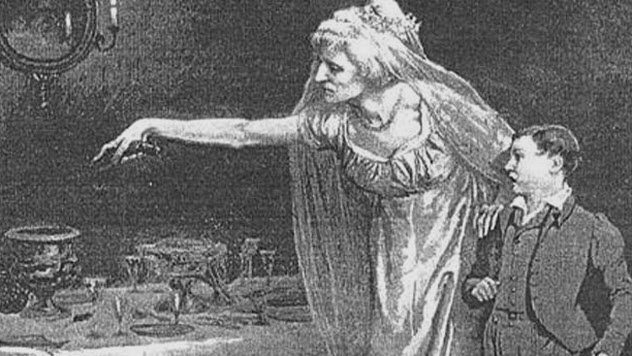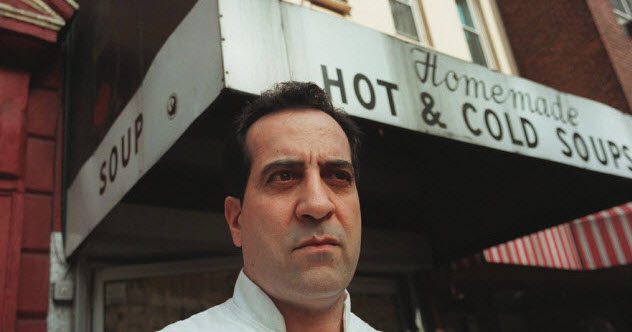 Animals
Animals  Animals
Animals  Facts
Facts Ten Unexpectedly Fascinating Facts About Rain
 Crime
Crime 10 Dark Details of Australia’s Gruesome Unsolved Wanda Murders
 Humans
Humans 10 Unsung Figures Behind Some of History’s Most Famous Journeys
 Animals
Animals 10 Species That Refused to Go Extinct
 Weird Stuff
Weird Stuff 10 Weird Things People Used to Do at New Year’s
 Our World
Our World 10 Archaeological Discoveries of 2025 That Refined History
 Weird Stuff
Weird Stuff 10 Fascinating Facts You Might Not Know About Snow
 Miscellaneous
Miscellaneous Top 10 Things Crypto Was Supposed to Change & What Actually Did
 History
History 10 Huge Historical Events That Happened on Christmas Eve
 Animals
Animals 10 Strange Times When Species Evolved Backward
 Facts
Facts Ten Unexpectedly Fascinating Facts About Rain
 Crime
Crime 10 Dark Details of Australia’s Gruesome Unsolved Wanda Murders
Who's Behind Listverse?

Jamie Frater
Head Editor
Jamie founded Listverse due to an insatiable desire to share fascinating, obscure, and bizarre facts. He has been a guest speaker on numerous national radio and television stations and is a five time published author.
More About Us Humans
Humans 10 Unsung Figures Behind Some of History’s Most Famous Journeys
 Animals
Animals 10 Species That Refused to Go Extinct
 Weird Stuff
Weird Stuff 10 Weird Things People Used to Do at New Year’s
 Our World
Our World 10 Archaeological Discoveries of 2025 That Refined History
 Weird Stuff
Weird Stuff 10 Fascinating Facts You Might Not Know About Snow
 Miscellaneous
Miscellaneous Top 10 Things Crypto Was Supposed to Change & What Actually Did
 History
History 10 Huge Historical Events That Happened on Christmas Eve
Top 10 People Who Inspired Iconic Fictional Characters
Sometimes when creating fiction, authors look for inspiration in real life. History has no shortage of captivating figures whose lives (or, at least, parts of them) would make for fascinating stories.
Occasionally, the characters based on them can become even more popular, to the point where people forget that they were inspired by real people. Here are 10 cases where we’ve largely forgotten the individuals who were the basis for iconic fictional characters.
10 Wilhelm Reich
Durand Durand

Austrian psychoanalyst Wilhelm Reich, a student of Sigmund Freud, was a strong believer in the power of sex. Specifically, Reich thought that most of society’s ills could be fixed through regular, satisfying orgasms. He even came up with a new type of energy called orgone, which was the physical representation of the libido. Orgone built up in the body until it was released through sex.
When Reich came to America to escape the Nazis, he built a device called an orgone accumulator which was meant to harness the power of this energy. He even asked Albert Einstein to investigate the machine. Einstein did and, unsurprisingly, refuted Reich’s claims.
But this didn’t decrease his popularity. Reich was a hit with the counterculture generation who approved of his ideas for sexual liberation. Several icons of the era—such as Jack Kerouac, William S. Burroughs, and Norman Mailer—lauded Reich and his orgone accumulators.
Quite fittingly, Reich was immortalized in the sex sci-fi romp Barbarella as the evil scientist Durand Durand.[1] His orgone accumulator also makes an appearance, except that it is now called the excessive-pleasure machine and its goal is to cause death by orgasm.
9 Louis ‘Red’ Deutsch
Moe Szyslak

One of the most popular running gags on The Simpsons involves Bart prank-calling Moe’s Tavern. Bart asks for joke names such as “Amanda Hugginkiss” or “Ivana Tinkle,” which Moe promptly shouts throughout the entire bar to the amusement of his patrons. When he realizes he’s been tricked yet again, Moe delivers an angry, threat-filled rant before slamming down the phone.
The gag debuted during the show’s first season in one of Moe Szyslak’s first appearances. However, The Simpsons creator Matt Groening took his inspiration from a series of pranks unofficially known as the Tube Bar prank calls which became popular during the early 1980s.
Two men named Jim Davidson and John Elmo would ring up the Tube Bar in Jersey City and ask to speak with people such as “Al Coholic” or “Pepe Roni.” Like Moe, the owner of the bar was an angry, retired boxer named Louis “Red” Deutsch.[2] When he realized he was being pranked, Red would start swearing and shouting threats at the callers.
Also like Moe, Red never got his hands on his tormentors. But his vulgar rants became popular as cassette recordings of the calls got passed around from person to person.
8 Eugene Chantrelle
Dr. Jekyll And Mr. Hyde

Scottish writer Robert Louis Stevenson is best remembered for his gothic classic The Strange Case of Dr. Jekyll and Mr. Hyde. It is a tale of good and evil that illustrates how one person can turn from an upstanding citizen into a monster given the right set of circumstances. According to writer and historian Jeremy Hodges, Stevenson saw that duality of man reveal itself firsthand during the trial of Eugene Chantrelle.
Born in Nantes, Eugene Chantrelle moved to Edinburgh where he taught French. He first met Stevenson through a mutual acquaintance, the author’s former French master, Victor Richon. Afterward, the two bonded when a chance encounter led to a long drinking session in the pub while discussing their mutual love of Moliere. Later, Stevenson was present at Chantrelle’s trial when the teacher was accused of killing his wife.[3]
Eugene Chantrelle married his former pupil, Elizabeth Dyer, in 1877. He took out an insurance policy on her life and poisoned her a year later. Chantrelle was convicted after investigators found traces of opium in Dyer’s vomit. Subsequently, there were allegations that he was responsible for other murders in France and England.
Hodges claimed to have uncovered notes that Stevenson took during the trial. Stevenson described it as a “traumatic experience.” He wrote that he could believe Chantrelle was a heinous criminal were it not for someone who was his “exact counterpart in looks” who was a model of kindness and good conduct.
7 Joseph Bell
Sherlock Holmes

Several people were hailed as the inspiration for Sherlock Holmes. But the one who lent the detective his trademark implacable reasoning and keen powers of observation was Scottish surgeon Joseph Bell.
Arthur Conan Doyle was Bell’s student at the University of Edinburgh and later worked as his clerk. Doyle got to see up close how Bell emphasized the importance of careful observation when making a diagnosis.
That way, Bell could pick up on all the small details, or “trifles” as he called them, which gave him insight into a stranger’s habits, occupation, and recent activities. This was a technique which would later be regularly employed by Doyle’s detective upon meeting new people.[4]
Doyle made sure to send Bell a copy of each new Sherlock Holmes story that was published. While the surgeon was flattered by the extra praise, he also hoped that people who really knew him didn’t see much of Holmes in him. Bell was tidy, modest, humorous, and kindhearted unlike the detective who regularly displayed callousness and a lack of humor.
Although Joseph Bell was a pioneer of forensic science, he never had much cause to work with the police, unlike Sherlock Holmes. There were several notable exceptions, however, including the Ripper case where Bell provided an analysis. Most noteworthy was the Ardlamont mystery of 1893 where Bell was called to provide expert testimony.
6 Donald Sinclair
Basil Fawlty

In 1975, a TV show named Fawlty Towers made its debut on British television to little fanfare. It ended after just 12 episodes, yet it is even now consistently ranked among the greatest British TV programs of all time.
A huge reason for that enduring success was the show’s lead character, hotel manager Basil Fawlty. Played and written by Monty Python member John Cleese, Fawlty was snobbish, misanthropic, and abusive toward his guests and his staff. A lot of praise was heaped on Cleese for conceiving such a character, but he had a little help courtesy of the man who served as the muse for the stuffy hotelier.
His name was Donald Sinclair. After serving in World War II, he managed two hotels in Torquay alongside his wife, Beatrice. The Pythons stayed at his Gleneagles Hotel in 1970 while filming nearby.
Eventually, Sinclair’s eccentric behavior forced all of them to find other accommodations. This excluded John Cleese and his wife, Connie Booth, because, according to him, they “were lazy.”[5] Instead, they stayed behind and got to observe Donald Sinclair in all his glory.
In the decades following his death, Sinclair’s wife claimed that her husband was nothing like Basil Fawlty but others begged to differ. While other Pythons backed up Cleese’s interpretation, former hotel staff also saw plenty of similarities between the two. While Fawlty may have been exaggerated, the real Sinclair was also an ill-tempered, constantly put-upon man who almost resented having guests in the hotel.
5 Eliza Emily Donnithorne
Miss Havisham

In Great Expectations, Charles Dickens created one of the most enduring tragic characters in English literature in the form of Miss Havisham. A wealthy heiress, she turned into a recluse who always wore her wedding dress after being jilted at the altar.
Several real women have been put forward as potential prototypes for Miss Havisham. As Dickens never revealed his true inspiration, it is impossible to say if any are accurate. However, the one who uncannily mirrored Miss Havisham’s tragic event was Eliza Emily Donnithorne of Sydney, Australia.
Born in 1826, Eliza Donnithorne was the daughter of an East India Company official and inherited most of his estate upon his death. At 31, she was supposed to get married, but her groom never arrived on her wedding day.
Unlike Compeyson in the novel, he wasn’t a swindler but rather was never heard from again. Despaired by this development, Eliza never left her house again, allowing only her servants, doctor, and solicitor to see her.[6] The wedding food was left on the tables to rot, and according to legend, the front door was always left ajar in case the groom might one day return.
The link between Miss Havisham and Miss Donnithorne cannot be proven with certainty, and some even argue that it was established the other way around after the book came out. Even so, the New South Wales Dickens Society believes in the connection and has organized several trips to Eliza’s grave at Camperdown Cemetery.
4 Carlson Brothers
Hanson Brothers

In 1977, Paul Newman starred in the comedy classic Slap Shot. It went on to be praised as one of the best sports movies of all time, and Maxim magazine even named it the “Best Guy Movie of All Time.” The story revolves around a down-and-out minor league hockey team that resorts to a violent play-style to gain popularity.
Key to this new strategy was the Hanson brothers, three players who acted as enforcers and served as the team’s primary muscle. Comically, their violent actions were countered by their nerdy look which included thick, black-rimmed glasses and a penchant for playing with toys. Even more bizarre, they were based on three real hockey players called the Carlson brothers.
This entry is unique in that the real-life models actually played their fictional counterparts. Two of the three Hanson brothers were played by Steve and Jeff Carlson.[7] The third Carlson brother had to bow out of filming because he was called up by the Edmonton Oilers to play in the playoffs in the World Hockey Association.
The Carlson brothers played with the Johnstown Jets alongside Ned Dowd, brother of screenwriter Nancy Dowd. Ned was the one who inspired her to write Slap Shot and to include characters based on the Carlsons. Originally, they were supposed to be played by actors. However, the production team couldn’t find actors who could skate well enough so they decided to cast the real deal instead.
3 Charles Frederick Field
Inspector Bucket

Charles Dickens was a writer who liked to stay up-to-date with bizarre events in England and abroad and often used them as inspiration for his stories. The novel Bleak House revolved around the seemingly interminable court case of Jarndyce v. Jarndyce. Dickens mentioned in the preface that he based it on two real cases which, at that time, had been going on for decades and had no end in sight.
The novel’s undaunted Inspector Bucket is also based on a real person—Inspector Charles Frederick Field of Scotland Yard.[8] He joined the Metropolitan Police when it formed in 1829 and later switched to the detective branch.
During that time, he formed a friendship with Charles Dickens, who showed particular interest in the development of London’s police force and was often allowed to tag along during rounds. In turn, Dickens wrote several articles about the detectives for the magazine he edited, Household Words, including an essay titled “On Duty with Inspector Field.”
Field retired in 1852, just in time to enjoy the newfound fame from the serialization of Bleak House. He opened a private detective office and garnered some additional attention a few years later when he worked as an investigator in the case of William Palmer, the Rugeley Poisoner.
2 Al Yeganeh
The Soup Nazi

Despite appearing in only one episode of Seinfeld, the Soup Nazi remains one of the show’s most well-known and beloved characters. Actor Larry Thomas even earned an Emmy nomination for the role. But curiously, he did not know at the time that it was based on a real person.
The original soup man was named Al Yeganeh. He set up Soup Kitchen International in Midtown Manhattan in 1984. While his restaurant was always in demand, Yeganeh’s popularity skyrocketed after being featured in the classic 1995 Seinfeld episode. Just like his TV show counterpart, the chef became known for his delicious soups made from fresh ingredients and his gruff, even abusive demeanor.
Unsurprisingly, Yeganeh was not amused by the show and has accused Seinfeld of ruining him multiple times. Even so, he managed to open a chain of “Original Soup Man” restaurants and, on occasion, used references to the show to promote his business. More recently, Yeganeh had to file for bankruptcy after his company’s CFO was indicted on federal tax evasion charges.[9]
1 Dave Toschi
The Loose Cannon Cop

Every no-nonsense, badass cop portrayed in movies since the 1970s has one man to thank for inspiration—San Francisco PD Inspector Dave Toschi. Joining the department in 1952, Toschi started working Homicide in 1966. Just three years later, he was put in charge of the investigation of the notorious Zodiac Killer.
Around the same time, the silver screen saw the first cop based on Toschi’s gruff and straightforward demeanor—Steve McQueen’s Frank Bullitt. The two had worked together before, and McQueen felt that he had exactly what it takes to make his character stand out. He even copied Toschi’s unique shoulder holster position which he held upside down for a faster draw.
Of course, Toschi’s real brush with fame came when the Zodiac Killer case started making national headlines. A couple of years later, Dirty Harry came out, which was primarily based on the Zodiac. Toschi inspired one of the most iconic characters in cinema history, Inspector “Dirty” Harry Callahan.
The San Francisco inspector’s latest tangle with Hollywood happened in 2007 when David Fincher released Zodiac. Aiming to show the real investigation behind the case, the film featured Dave Toschi as one of the main characters, played by Mark Ruffalo.
The actor spent time with the retired policeman to nail his look and behavior down to Toschi’s love of bow ties and animal crackers.[10] The film even includes a scene where Toschi goes to see Dirty Harry and becomes angered by Callahan’s “take-no-prisoners” tactics.
Read about more famous fiction that’s based on reality on 10 Fictional Characters Based On Real People and 10 Famous Works Of Fiction Based On Real Crimes.








